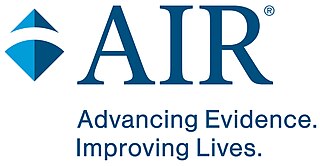
The SAT is a standardized test widely used for college admissions in the United States. Since its debut in 1926, its name and scoring have changed several times. For much of its history, it was called the Scholastic Aptitude Test and had two components, Verbal and Mathematical, each of which was scored on a range from 200 to 800. Later it was called the Scholastic Assessment Test, then the SAT I: Reasoning Test, then the SAT Reasoning Test, then simply the SAT.

Head Start is a program of the United States Department of Health and Human Services that provides comprehensive early childhood education, health, nutrition, and parent involvement services to low-income children and families. The program's services and resources are designed to foster stable family relationships, enhance children's physical and emotional well-being, and establish an environment to develop strong cognitive skills. The transition from preschool to elementary school imposes diverse developmental challenges that include requiring the children to engage successfully with their peers outside the family network, adjust to the space of a classroom, and meet the expectations the school setting provides.
Survey methodology is "the study of survey methods". As a field of applied statistics concentrating on human-research surveys, survey methodology studies the sampling of individual units from a population and associated techniques of survey data collection, such as questionnaire construction and methods for improving the number and accuracy of responses to surveys. Survey methodology targets instruments or procedures that ask one or more questions that may or may not be answered.
Intellectual giftedness is an intellectual ability significantly higher than average. It is a characteristic of children, variously defined, that motivates differences in school programming. It is thought to persist as a trait into adult life, with various consequences studied in longitudinal studies of giftedness over the last century. There is no generally agreed definition of giftedness for either children or adults, but most school placement decisions and most longitudinal studies over the course of individual lives have followed people with IQs in the top 2.5 percent of the population—that is, IQs above 130. Definitions of giftedness also vary across cultures.
Gifted education is a sort of education used for children who have been identified as gifted and talented.
The Monitoring the Future (MTF) study, also known as the National High School Senior Survey, is a long-term epidemiological study that surveys trends in legal and illicit drug use among American adolescents and adults as well as personal levels of perceived risk and disapproval for each drug. The survey is conducted by researchers at the University of Michigan's Institute for Social Research, funded by research grants from the National Institute on Drug Abuse, one of the National Institutes of Health.
A longitudinal study is a research design that involves repeated observations of the same variables over long periods of time. It is often a type of observational study, although it can also be structured as longitudinal randomized experiment.

Lewis Madison Terman was an American psychologist, academic, and proponent of eugenics. He was noted as a pioneer in educational psychology in the early 20th century at the Stanford School of Education. Terman is best known for his revision of the Stanford–Binet Intelligence Scales and for initiating the longitudinal study of children with high IQs called the Genetic Studies of Genius. As a prominent eugenicist, he was a member of the Human Betterment Foundation, the American Eugenics Society, and the Eugenics Research Association. He also served as president of the American Psychological Association. A Review of General Psychology survey, published in 2002, ranked Terman as the 72nd most cited psychologist of the 20th century, in a tie with G. Stanley Hall.
The National Center for Education Statistics (NCES) is the part of the United States Department of Education's Institute of Education Sciences (IES) that collects, analyzes, and publishes statistics on education and public school district finance information in the United States. It also conducts international comparisons of education statistics and provides leadership in developing and promoting the use of standardized terminology and definitions for the collection of those statistics. NCES is a principal agency of the U.S. Federal Statistical System.
Julian Cecil Stanley was an American psychologist. He was an advocate of accelerated education for academically gifted children. He founded the Johns Hopkins University Center for Talented Youth (CTY), as well as a related research project, the Study of Mathematically Precocious Youth (SMPY), whose work has, since 1980, been supplemented by the Julian C. Stanley Study of Exceptional Talent (SET), which provides academic assistance to gifted children. Stanley was also widely known for his classic book, coauthored with Donald Campbell, on the design of educational and psychological research - Experimental and Quasi-experimental Designs for Research.

Research design refers to the overall strategy utilized to carry out research that defines a succinct and logical plan to tackle established research question(s) through the collection, interpretation, analysis, and discussion of data.
Center for Talent Development (CTD), established in 1982, is a direct service and research center in the field of gifted education and talent development based at Northwestern University.
Understanding Society, the UK Household Longitudinal Study (UKHLS), is one of the largest panel survey in the world, supporting social and economic research. Its sample size is 40,000 households from the United Kingdom or approximately 100,000 individuals.
John Clemans Flanagan, was a noted psychologist most known for developing the critical incident technique, which identifies and classifies behaviors associated with the success or failure of human activity. He was a pioneer of aviation psychology. During World War II Flanagan was commissioned by the U.S. Army Air Forces in 1941 to head an aviation psychology program that developed tests to help identify pilots suitable for combat missions.

Robert Richardson Sears was an American psychologist who specialized in child psychology and the psychology of personality. He was the head of the psychology department at Stanford and later dean of the School of Humanities and Sciences there, continued the long-term I.Q. studies of Lewis Madison Terman at Stanford, and authored many pivotal papers and books on various aspects of psychology.
The Study of Mathematically Precocious Youth (SMPY) is a prospective longitudinal survey study of persons identified by scores of 700 or higher on a section of the SAT Reasoning Test before age 13. It is one of the longest-running longitudinal studies of gifted youth. Study scholars have used its data to assess hypotheses about talent development and occupational preferences.
Professor Wei-Jun Jean Yeung is a Taiwanese sociologist and demographer, now is the professor of Asia Research Institute, National University of Singapore. She chairs the Family, Children, and Youth Research Cluster in the Faculty of Arts and Social Sciences in NUS.
The Future of Families and Child Wellbeing Study (FFCWS) is a longitudinal birth cohort study of American families. Formerly known as the Fragile Families and Child Wellbeing Study, the study’s name was changed in January 2023.

The American Institutes for Research (AIR) is a nonprofit, nonpartisan behavioral and social science research, evaluation and technical assistance organization based in Arlington, Virginia. One of the world's largest social science research organizations, AIR has more than 1,800 staff in locations across the United States and abroad.

High School and Beyond (HS&B) is a longitudinal study of a nationally representative sample of people who were high school sophomores and seniors in 1980. The study was originally funded by the United States Department of Education’s National Center for Education Statistics (NCES) as a part of their Secondary Longitudinal Studies Program. NORC at the University of Chicago, then known as the National Opinion Research Center, developed the sample design and performed the data collection for the study. The study surveyed students from over 1,000 public and private high schools on their cognitive and non-cognitive skills, high school experiences, work experiences, and future plans. Baseline surveys were administered in 1980, with follow-up surveys in 1982, 1984, 1986, 1992 (sophomores), 2014 (sophomores), and 2015 (seniors).







